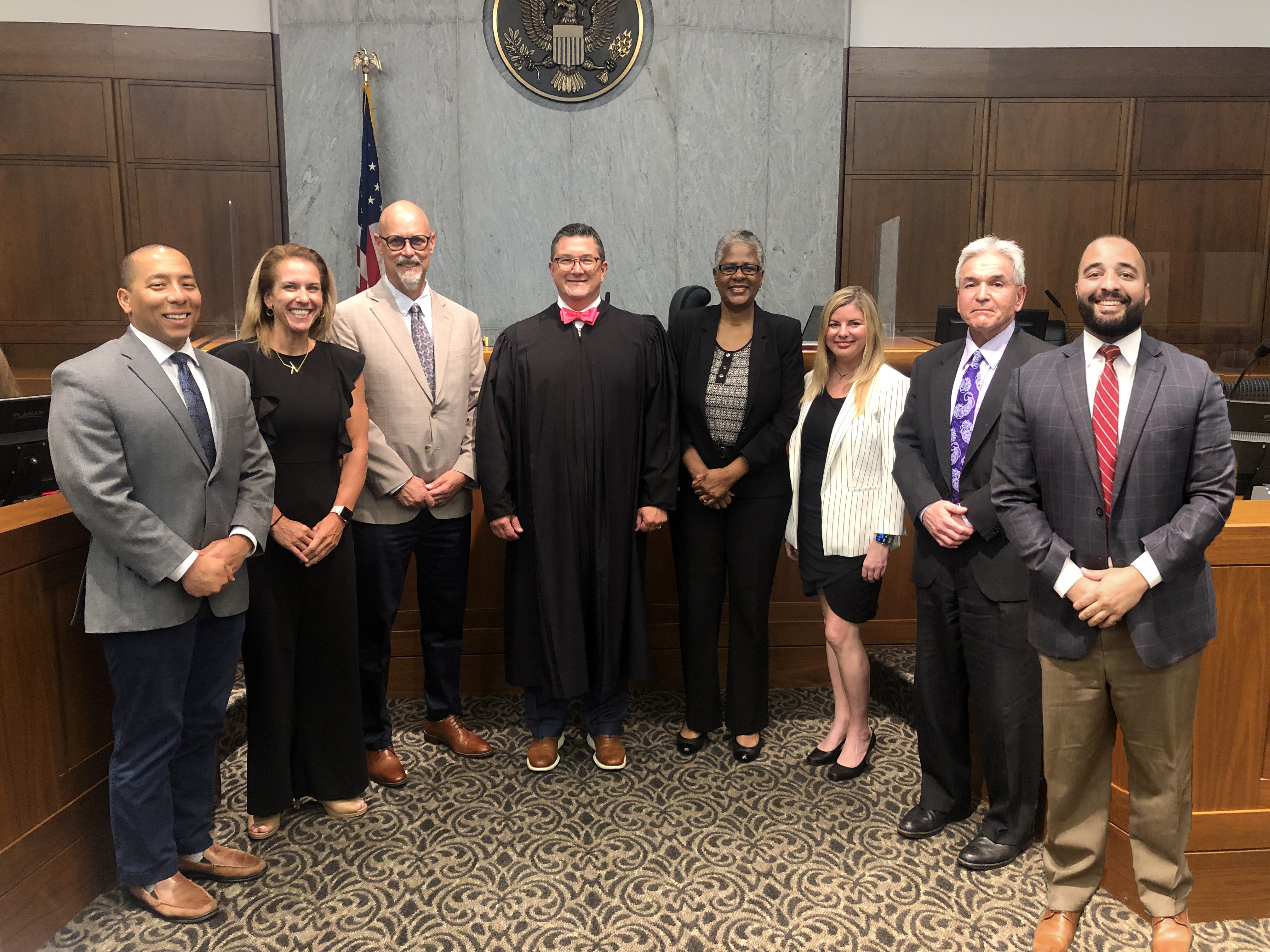The mission of the Western District of Missouri's Re-entry Court is to provide alternative programming for individuals who are on federal supervision and have significant substance abuse treatment needs. The program is based on the belief that if offenders with substance abuse problems are offered the right type of assistance and held accountable, they may stand a better chance of leading a drug-free and law-abiding life than would otherwise be the case. Re-entry Court was designed to assist participants by providing a judicially-supervised regimen of treatment, supervision, and innovative case management. The program, which has demonstrated positive results throughout the country, was crafted in a manner to improve participant outcomes, thereby reducing recidivism, conserving judicial resources, and making a positive difference in the lives of those we serve.
>> View Western Missouri's Program in the News
 The Re-entry Court was developed through a partnership between the U.S. District Court, U.S. Attorney's Office, Federal Public Defender's Office, U.S. Probation and Pretrial Office, and a contracted substance abuse treatment provider. The above entities also comprise the RE-Entry Court Team and are present at each Court hearing. The Court, through these entities, provides multi-faceted support to the participant, and accomplishes its mission by combining a program of intense supervision, the best practices in addiction treatment, and timely court intervention.
The Re-entry Court was developed through a partnership between the U.S. District Court, U.S. Attorney's Office, Federal Public Defender's Office, U.S. Probation and Pretrial Office, and a contracted substance abuse treatment provider. The above entities also comprise the RE-Entry Court Team and are present at each Court hearing. The Court, through these entities, provides multi-faceted support to the participant, and accomplishes its mission by combining a program of intense supervision, the best practices in addiction treatment, and timely court intervention.
Eligibility for Re-entry Court is determined when the offender is at the local Residential Re-entry Center (RRC) and within 90 days of their release from custody. Upon their release from custody, the participant enters the first of four phases of the Re-entry Court. Each phase of the program has a specific purpose with distinct and achievable goals. Within each phase, the participant has to show positive performance in three domains, which include supervision, employment, and treatment/recovery. During the course of the program, the participant must adhere to the requirements of each phase and attend regularly scheduled court hearings through which their adjustment and progress is monitored by the team.
One of the unique aspects of Re-entry Court is the nontraditional manner in which the Judge interacts with the participants. The Judge combines attributes of both a judge and a parent in order to assist participants with their assimilation back into society and to reduce their risk of recidivism. The judge applies concepts of positive and negative reinforcement, and the reinforcement occurs swiftly and in an impactful manner. The Re-entry Court Program allows the Judge and other team members to take an early and more active role in a participant's supervision.
Incremental rewards and incentives are utilized during the program to recognize a participant's achievements. Upon successful completion of Re-entry Court, the participant's term of supervised release (TSR) is reduced by order of the Judge. A three-year term of TSR can be reduced by up to one year. A four-year term of TSR can be reduced by up to one and one-half years, and a five-year term of TSR can be reduced by up to two years. However, a participant's failure to abide by the mandates of Re-entry Court may result in the imposition of sanctions, including termination from the program and re-assignment to traditional supervision.
Re-entry Court Success Rate
Re-entry Court had its first graduating class in February 2011. Since then there have been 22 graduation ceremonies and 78 total graduates. Through extensive analysis and tracking we are able to proudly report a statistical significant higher success rate for re-entry court participants.
Of the 78 graduates, 60 have successfully completed their remaining term of supervised release. Since graduation results in a reduced term of supervise release, the participants’ success has resulted in a total cost savings of $462,852 to taxpayers. 10 graduates were unsuccessful while completing their remaining term of supervised release and 8 are still serving with a future expiration date. A graduate from re-entry court has an 85.7% success rate, meaning they compete their term of supervised release, do not pick up any new charges, and are not reincarcerated for any reason.
Our control group are individuals who are eligible to participate in re-entry court but chose not to participate. There are 179 of these individuals, with 60 still on supervision, 65 have successfully completed supervision, and 54 who were either revoked or incurred new charges. The success rate for our control group is 54.6%.
In short, the intensive supervision and hard work by participants of re-entry court results in a 30% higher success rate. We also believe the additional tools for success, the focus on job skills, and the counseling related to dependency issues not only saves taxpayers money, it also provides our participants the ability to live crime-free, drug-free, and maintain good paying jobs.
- The Re-entry court thanks Olivia Price, our intern over the summer of 2019, for her outstanding work on collecting and analyzing this data. Her hard work will have a lasting impact on the program.
- For a more thorough explanation of Re-entry Court, including a detailed breakdown of each of the four phases of the program, please consult our Guide to Re-Entry Court, assembled by Delaney McCoy, our excellent summer intern from 2021. Other courts and interested parties will benefit from her exemplary work.
For additional information or to obtain a copy of documents associated with the Western District of Missouri' s Re-entry Court, contact Senior U.S. Probation Officer, Program Specialist, Katie Meister at 816-512-1309.
